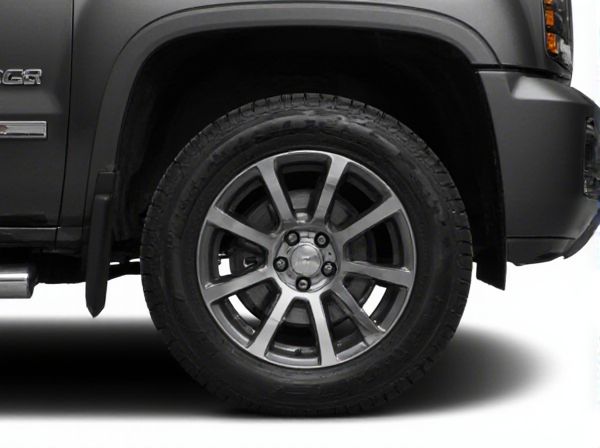
Photo illustration: Staggered Fitment vs Square Fitment Wheel
Staggered fitment wheels feature different sizes on the front and rear axles, improving handling and traction by optimizing tire width for each end of the vehicle. Square fitment wheels use the same size tires on all four corners, providing more uniform wear and easier tire rotation. You should choose staggered fitment for enhanced performance and aggressive styling, while square fitment offers balanced handling and cost-efficient maintenance.
Table of Comparison
| Feature | Staggered Fitment | Square Fitment |
|---|---|---|
| Wheel Size | Larger rear wheels, smaller front wheels | Equal size wheels on all corners |
| Traction | Improved rear traction, ideal for RWD | Balanced traction on all wheels |
| Handling | Enhanced straight-line stability | Better cornering balance and predictability |
| Tire Rotation | Not possible, limited tire life management | Possible, extends tire lifespan |
| Cost | Higher due to mixed wheel and tire sizes | Lower, uniform tires reduce cost |
| Common Use | Sports cars and performance RWD vehicles | AWD vehicles and daily drivers |
Understanding Staggered Fitment Wheels
Staggered fitment wheels feature larger rear wheels compared to the front, enhancing traction and handling in performance vehicles by optimizing power distribution to the rear tires. This setup improves stability during acceleration and cornering, especially in rear-wheel-drive cars, by providing wider contact patches at the back. Staggered wheels also offer an aggressive aesthetic appeal, contributing to both function and style in sports and luxury vehicles.
What Is Square Fitment?
Square fitment refers to using the same size wheels and tires on all four corners of a vehicle, ensuring uniformity in performance and handling characteristics. This setup enhances tire rotation flexibility and extends tire life by allowing even wear distribution, which is ideal for balanced driving dynamics. Square fitment is often preferred for drivers seeking predictable handling and simplified maintenance compared to staggered fitment, where wheel sizes differ between front and rear axles.
Key Differences Between Staggered and Square Fitments
Staggered fitment wheels feature larger, wider tires on the rear axle compared to the front, optimizing traction and handling for rear-wheel-drive vehicles, while square fitment uses identical tire sizes on all four corners to promote even wear and easier tire rotation. Staggered setups enhance rear grip and aggressive styling but limit tire rotation options, potentially increasing tire wear on front wheels, whereas square fitments improve tire longevity and balance but may sacrifice some rear traction. Choosing between staggered and square fitments depends on vehicle drivetrain, intended use, and preferences for performance versus maintenance.
Performance Implications of Staggered Fitment
Staggered fitment wheels, featuring wider rear tires compared to the front, significantly enhance traction and cornering stability by improving rear grip and reducing understeer in high-performance vehicles. This setup optimizes power delivery during acceleration, especially in rear-wheel-drive cars, resulting in better handling dynamics and increased stability at high speeds. However, staggered fitment can lead to uneven tire wear and limit tire rotation options, impacting long-term maintenance and overall tire lifespan.
Performance Implications of Square Fitment
Square fitment wheels, where all four wheels share identical sizes and offsets, promote balanced handling by ensuring consistent tire contact patch and uniform traction across all corners. This setup enhances predictable cornering stability and tire wear, improving overall vehicle dynamics, especially in high-performance vehicles designed for balanced weight distribution. Performance gains from square fitment include more efficient power delivery, optimized grip during acceleration and braking, and easier tire rotation, prolonging tire life and maintaining consistent performance.
Aesthetic Impact: Which Fitment Looks Better?
Staggered fitment wheels, featuring larger rear wheels than the front, often create a more aggressive, performance-oriented stance that enhances the vehicle's sporty aesthetic appeal. Square fitment wheels, with equal sizes on all corners, provide a balanced and symmetrical look that emphasizes simplicity and uniformity. The choice between staggered and square fitment hinges on personal preference, with staggered setups favored for visual dynamism and square setups appreciated for their clean, cohesive appearance.
Vehicle Compatibility and Fitment Choices
Staggered fitment wheels offer varying tire widths between the front and rear, enhancing traction and handling on rear-wheel-drive sports cars like the BMW M3 and Ford Mustang. Square fitment wheels use identical tire sizes on all four corners, promoting even tire wear and balanced performance suitable for all-wheel-drive vehicles such as the Subaru WRX and Audi Quattro. Choosing between staggered and square fitment depends on vehicle drivetrain layout and desired driving dynamics, with compatibility influenced by manufacturer specifications and aftermarket customization options.
Pros and Cons of Staggered Fitment
Staggered fitment wheels, featuring wider tires at the rear than the front, enhance traction and improve handling in high-performance vehicles, especially during acceleration and cornering. However, they can lead to uneven tire wear and increased tire replacement costs due to the requirement for mismatched tires, limiting tire rotation options. Staggered setups also reduce the ability to use all-wheel-drive systems effectively and may cause slight understeer in certain driving conditions.
Pros and Cons of Square Fitment
Square fitment wheels provide uniform tire sizes on all four corners, enhancing tire rotation options and extending tread life through balanced wear distribution. This setup often results in predictable handling characteristics, making it ideal for daily driving and consistent performance. However, square fitment may limit aggressive cornering grip compared to staggered setups, which use wider rear tires to improve rear traction and stability during high-performance driving.
Choosing the Right Fitment for Your Vehicle
Choosing the right fitment for your vehicle depends on performance goals and aesthetic preferences, with staggered fitments offering wider rear wheels for improved traction and handling, especially on rear-wheel-drive cars, while square fitments provide equal tire sizes on all corners, enhancing tire rotation flexibility and balanced wear. Staggered fitments often improve cornering grip but limit tire rotation options, potentially increasing tire replacement costs. Square fitments promote even tire wear and simplified maintenance, making them ideal for all-wheel-drive vehicles or drivers prioritizing longevity and uniform performance.
 caratoz.com
caratoz.com